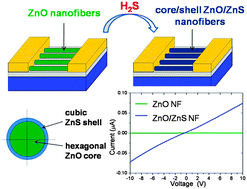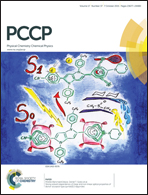Facile synthesis of core/shell ZnO/ZnS nanofibers by electrospinning and gas-phase sulfidation for biosensor applications†
Abstract
This study describes a new method of passivating ZnO nanofiber-based devices with a ZnS layer. This one-step process was carried out in H2S gas at room temperature, and resulted in the formation of core/shell ZnO/ZnS nanofibers. This study presents the structural, optical and electrical properties of ZnO/ZnS nanofibers formed by a 2 nm ZnS sphalerite crystal shell covering a 5 nm ZnO wurtzite crystal core. The passivation process prevented free carriers from capture by oxygen molecules and significantly reduced the impact of O2 on nanostructure conductivity. The conductivity of the nanofibers was increased by three orders of magnitude after the sulfidation, the photoresponse time was reduced from 1500 s to 30 s, and the cathodoluminescence intensity increased with the sulfidation time thanks to the removal of ZnO surface defects by passivation. The ZnO/ZnS nanofibers were stable in water for over 30 days, and in phosphate buffers of acidic, neutral and alkaline pH for over 3 days. The by-products of the passivation process did not affect the conductivity of the devices. The potential of ZnO/ZnS nanofibers for protein biosensing is demonstrated using biotin and streptavidin as a model system. The presented ZnS shell preparation method can facilitate the construction of future sensors and protects the ZnO surface from dissolving in a biological environment.


 Please wait while we load your content...
Please wait while we load your content...